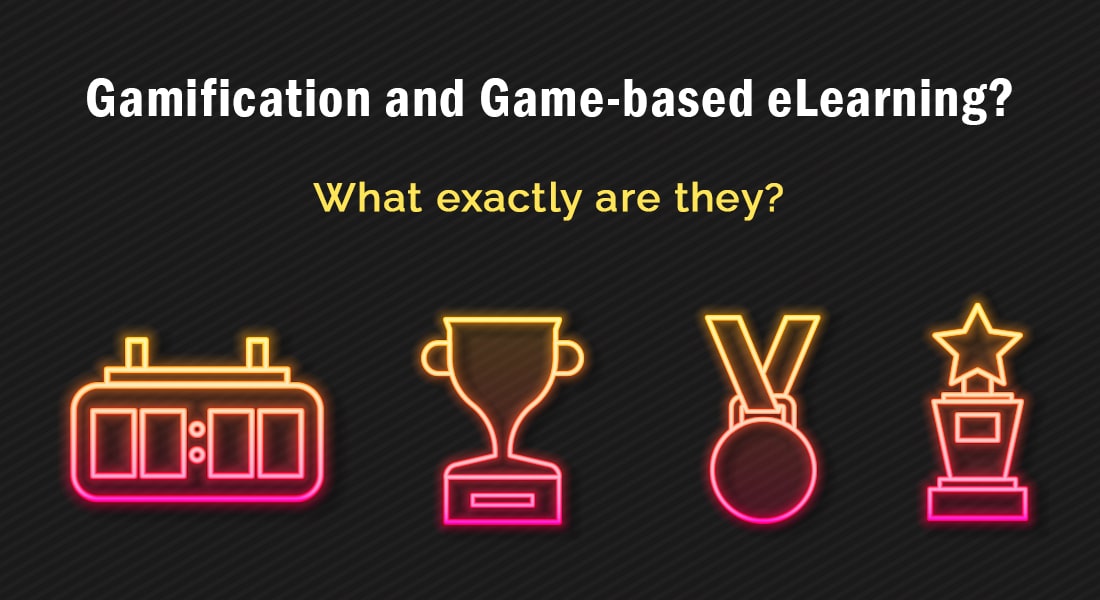Gamification vs. Game-based eLearning: What’s the Deal?

As a training manager, you know how important it is to have well-designed online courses in your training arsenal as you work on your training initiatives for your learners. The more engaging an online course, the higher the learner participation. A lot of eLearning courses use scenarios and other interactivities that make them more relatable to learners. Play or edutainment is another hot favorite with today’s learners.
Edutainment adds an element of fun to your eLearning, and this blog takes a close look at gamification and game-based learning, both of which can be used to make eLearning a lot more fun and exciting. Though the two terms appear interchangeable, they are not. We will discuss the differences between them and understand how each can be successfully implemented in your eLearning courses.
Explore eLearning trends to make courses learner-centric.
Decoding 2 Elements of Edutainment and Play in eLearning
Game-based Learning (GBL)
In game-based learning, the course is designed as a game to accomplish specific learning outcomes or teach specific skills to learners based on their learning requirements.
Though games are usually created (and used) solely for entertainment, gameplay can be used in an educational context where it adheres to defined learning objectives while allowing learners to have fun.
Gamification vs. Game-based eLearning
In game-based learning, the course is designed as a game to accomplish specific learning outcomes or teach specific skills. Gamification uses game elements such as rules, challenges, points, and goals to create a learning environment.
Here are a few best practices to include game-based learning in your instructional strategy.
Make learning objectives the focal point of game-based design: While games can be very exciting, the focus of your game-based e-learning course should be the learning objectives. If not, the course will not offer any real value to the learners. The eLearning game should be designed to help the learner achieve the learning objectives and provide key takeaways to modify learning behavior or improve their performance.
Make it challenging, not frustrating: The eLearning game needs to be designed in such a way that it is finely balanced between being too challenging and too easy. If it is too easy, learners tend to get bored and disengage from the learning. If it’s too challenging, learners may feel discouraged from continuing the game, which will also disengage them from the eLearning course.
The middle path would be to find a way to increase the difficulty level of the eLearning game gradually. You should consider the learners’ age, educational background, professional knowledge, and experience to design a truly immersive and engaging eLearning game that is just right for them.
Make it interactive and immersive: Including interactive scenarios can help learners relate to the characters and the situation and motivate them to go through the various levels. Including click actions or branching scenarios helps can increase learner participation in the game. Higher levels (advanced sections of the course) could be unlocked once a learner clear basic levels.
This brings us to gamification. How is it different from the game-based learning that we just discussed?
Gamification
Unlike game-based learning that designs the course around a game, gamification uses game elements such as rules, challenges, points, and goals to create a gaming environment. You can use gamification to encourage learners to participate in tasks that they usually consider boring. It does this by offering rewards for participation.
For instance, a leaderboard can display learners’ progress and encourage healthy competition among learners. Winning badges gives them a sense of accomplishment and pushes them to take other modules in the eLearning course.
Here are 3 tips for designing a successful gamified eLearning.
Keep it simple: If the gamified eLearning course has too many rules or guidelines, the learner may lose interest while going through the long list of rules itself! You should make sure that the game it’s not too complicated. Keep the structure and the mechanics of the game as simple as possible.
Explore ideas to incorporate gamification in the virtual classroom.
Acknowledge progress: Motivate learners by acknowledging their progress (either with rewards or points in the course) and offering words of praise when they do something right. This encourages the learner to continue with the e-learning course.
Focus on goal achievement: Though gamification of eLearning includes awarding points or badges to encourage learners, the focus should be on learning. Achieving the learning objectives should be the primary purpose of gamifying your eLearning course. Game mechanics must be tied to the set learning objectives – awarding a badge or points for each task that is achieved or each skill that is mastered.
Parting Thoughts
While gamification and game-based learning can motivate and inspire learners, it is important you choose the right approach. And that will depend on your learning objectives and goals.
Want to learn more about how you can leverage instructional design in your game-based eLearning courses and use gamification to make them more engaging? Download our free eBook on the basics of Instructional Design for eLearning designers.





